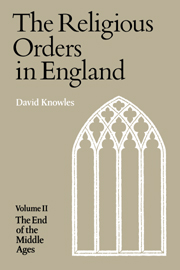Book contents
- Frontmatter
- Contents
- Preface
- List of Abbreviations
- Part One The Historical Framework
- Chap. I The opening of the period
- Chap. II Monks and canons at the university, 130c–1450
- Chap. III Patrons and architects: Ely and Gloucester
- Chap. IV Portraits of monks
- Chap. V Monks and friars in controversy
- Chap. VI Trends in speculation: Ockhamism, justification and grace
- Chap. VII Criticism of the religious in the fourteenth century
- Chap. VIII The spiritual life of the fourteenth century
- Chap. IX Developments within the orders: I
- Chap. X Developments within the orders: II
- Chap. XI The fortunes of the Cluniac houses and the alien priories
- Chap. XII The loosening of discipline
- Chap. XIII King Henry V
- Chap. XIV More portraits of monks
- Chap. XV The second century of visitation, 1350–1450
- Chap. XVI The spiritual life of the fifteenth century
- Part Two The Institutional Background
- Appendix I Chaucer's monk
- Appendix II Henry V and the Westminster recluse
- Appendix III Regulars as bishops
- Bibliography
- Index
Chap. XI - The fortunes of the Cluniac houses and the alien priories
Published online by Cambridge University Press: 28 January 2010
- Frontmatter
- Contents
- Preface
- List of Abbreviations
- Part One The Historical Framework
- Chap. I The opening of the period
- Chap. II Monks and canons at the university, 130c–1450
- Chap. III Patrons and architects: Ely and Gloucester
- Chap. IV Portraits of monks
- Chap. V Monks and friars in controversy
- Chap. VI Trends in speculation: Ockhamism, justification and grace
- Chap. VII Criticism of the religious in the fourteenth century
- Chap. VIII The spiritual life of the fourteenth century
- Chap. IX Developments within the orders: I
- Chap. X Developments within the orders: II
- Chap. XI The fortunes of the Cluniac houses and the alien priories
- Chap. XII The loosening of discipline
- Chap. XIII King Henry V
- Chap. XIV More portraits of monks
- Chap. XV The second century of visitation, 1350–1450
- Chap. XVI The spiritual life of the fifteenth century
- Part Two The Institutional Background
- Appendix I Chaucer's monk
- Appendix II Henry V and the Westminster recluse
- Appendix III Regulars as bishops
- Bibliography
- Index
Summary
Besides the autonomous black monk houses and their dependencies, there existed in England a large number of monastic bodies, some relatively important, the majority insignificant, who were controlled either directly or mediately by abbeys in France and Flanders. These, both by contemporaries in the later Middle Ages and by recent historians, have often been grouped together under the designation of ‘alien priories’. Actually, they fall into two distinct classes: the family of Cluny and the dependencies of autonomous foreign houses. The former had from the beginning the capacity, or at least the potentiality, for fruitful individual activity; the latter, so long as their status remained unchanged, enjoyed at the best a derivative life. In the twelfth century, when intercourse between these islands and the Continental dominions of the kings of England was close, the personnel of these houses differed little, if at all, from that of other English monasteries, but in the thirteenth century matters altered: the Cluniac houses, though often ruled by a French prior and containing a group of foreign monks, tended to draw their recruits from the countryside; the priories and cells depending directly on individual French houses, being for the most part too small to receive novices, came to be manned largely by foreigners. All of them remained entirely outside the jurisdiction of the presidents and provincial chapters of the black monks, and the Cluniac family was exempt also from episcopal surveillance, depending as it did, through Cluny, immediately upon the Holy See.
- Type
- Chapter
- Information
- Religious Orders Vol 2 , pp. 157 - 166Publisher: Cambridge University PressPrint publication year: 1979

